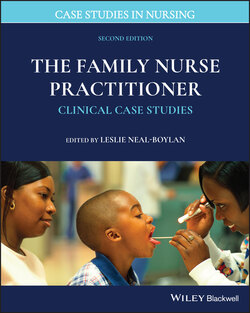Читать книгу The Family Nurse Practitioner - Группа авторов - Страница 50
ОглавлениеCase 5.8 Knee Pain
By Jessica Chan, MSN, APRN, PPCNP‐BC
SUBJECTIVE
Peter is a 16‐year‐old male who presents to your pediatric primary care office with complaints of right knee pain and swelling for 1 week. He can bear weight on his leg with only mild discomfort. He lives in New York City, but reports that he spent the summer working as a camp counselor in Madison, Connecticut. He resides at the camp while working there and spends his days hiking and doing outdoor activities. He has also participated in summer soccer clinics but does not recall a specific injury, and has attributed his occasional muscle aches to his activity levels. Peter denies any current rashes, but does state that he had a lot of bug bites and poison ivy exposure during his time working as a camp counselor and has generally ignored the symptoms. He describes a few weeks of feeling more tired with intermittent headaches, but believes it’s due to spending time in the sun and working with kids. He isn’t sure whether he has had a fever. He also denies any pain or swelling in other joints. He did not go see the nurse on‐site at the summer camp. He reports he is sleeping through the night and his appetite has been good with no recent weight loss.
Past medical history: Patient is a healthy 16‐year‐old male with no significant past medical history.
Family history: Maternal and paternal family history is unremarkable. Patient has 1 sibling, a sister, who is well. A maternal grandmother has rheumatoid arthritis, lupus, and hypertension.
Social history: Peter lives at home with his parents and younger sister. He has a pet dog that sleeps in his room. He is attending high school and in the 11th grade and is also an avid soccer player.
Medications: Daily multivitamin.
Allergies: Amoxicillin (hives, at age 2)
OBJECTIVE
Vital signs: Weight: 140 lbs; height: 68 inches; BMI: 21.3; temperature: 100.4°F; HR: 76; RR: 16; B/P: 108/72.
General: Alert, tired appearing but in no acute distress.
HEENT: Head is normocephalic and atraumatic. Scleras are clear. PERRLA bilaterally. Normal fundi exam bilaterally. Otoscopic exam reveals normal tympanic membranes with visible landmarks and appropriate light reflex. Nares are patent. Oropharynx is normal without erythema or exudate. Tongue is midline.
Skin: No rashes noted on exam. Skin is warm and dry.
Neck: No lymphadenopathy present. Full range of motion with no reported pain.
Respiratory: Lungs clear to auscultation bilaterally. No wheezes, rales, or rhonchi present.
Cardiovascular: Regular rate and rhythm. S1S2 normal. Pulses 2+ throughout.
Gastrointestinal: Abdomen soft, nontender, nondistended, with no masses or hepatosplenomegaly palpated. Bowel sounds normoactive in all 4 quadrants.
Neurological: Alert and oriented. Grossly normal. Sensation intact to lower extremities. Patellar and Achilles deep tendon reflexes 2+ bilaterally.
Musculoskeletal: Assessments of the joints, with a particular focus on those of his right lower extremity (hip and ankle) are normal with the exception of the right knee. Left lower extremity exam is normal, and there is obvious asymmetry between the two knees. To right lower extremity: minimal tenderness to the knee joint upon palpation. The knee feels warm to touch. Non‐pitting edema is present. Further exam displays a positive “bulge” sign, evidence of fluid collection in the joint, as well as a negative McMurray test and negative anterior drawer sign test/Lachman test. The patella tracks normally. Range of motion of the right knee is limited due to swelling, with full extension but flexion limited to only 90°. No hypermobility is noted. Full strength (5/5) is noted to right lower extremity, and Peter’s gait is normal with no limp at time of exam.
CRITICAL THINKING
1 Which diagnostic tests should be ordered in this case and why?___Complete blood count (CBC)___Comprehensive metabolic panel (CMP)___Erythrocyte sedimentation rate (ESR)___C‐reactive protein (CRP)___Rheumatoid factor___Anti‐nuclear antibody (ANA)___Lactic acid dehydrogenase (LDH)___Enzyme‐linked immunosorbent assay with reflex Western blot (ELISA)___X‐ray___Magnetic resonance imaging (MRI)___Synovial fluid (cell counts, Gram stain, culture and sensitivity, PCR)
2 What is the most likely differential diagnosis and why?___Infectious cause (septic arthritis, osteomyelitis, Lyme arthritis)___Autoimmune diseases (juvenile idiopathic arthritis, systemic lupus erythematous)___Trauma/Injury___Malignancy (tumor secondary to osteosarcoma, lymphoma, neuroblastoma)
3 What is the plan of treatment?
4 What are the plans for referral and follow‐up care?
5 What health education should be provided to this patient?
6 What demographic characteristics might affect this case?
7 Are there any standardized guidelines that should be used to treat this case? If so, what are they?
8 Is there any other information that would be helpful in determining a diagnosis?
9 If this patient were 6 years old, would it change how he would be tested and treated?
10 At what point would inpatient treatment be more appropriate than outpatient for this patient?
